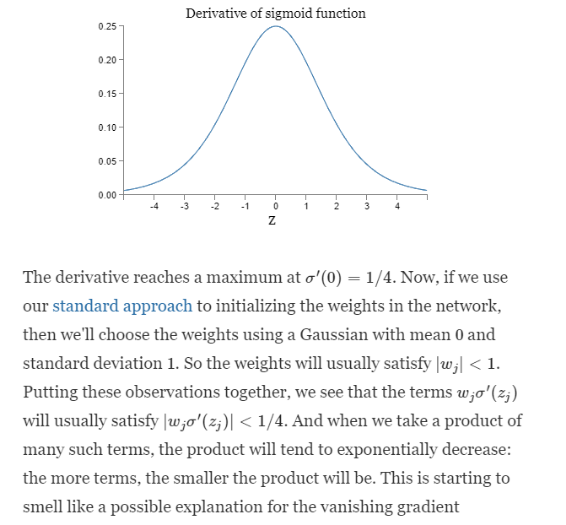Latest news about Bitcoin and all cryptocurrencies. Your daily crypto news habit.
Hello Stardust! Today we’ll see mathematical reason behind exploding and vanishing gradient problem but first let’s understand the problem in a nutshell.
“Usually, when we train a Deep model using through backprop using Gradient Descent, we calculate the gradient of the output w.r.t to weight matrices and then subtract it from respective weight matrices to make its(matrix’s) values more accurate to give correct output”
But what if the gradient becomes negligible?
When the gradient becomes negligible, subtracting it from original matrix doesn’t makes any sense and hence the model stops learning. This problem is called as Vanishing Gradient Problem.
We’ll first visualize the problem practically in our mind. We’ll train a Deep Learning Model with MNIST(you know this) dataset with 1,2,4 and 5 hidden layers and see the effect of using different architecture on the output(accuracy doesn’t increase always! 😵).
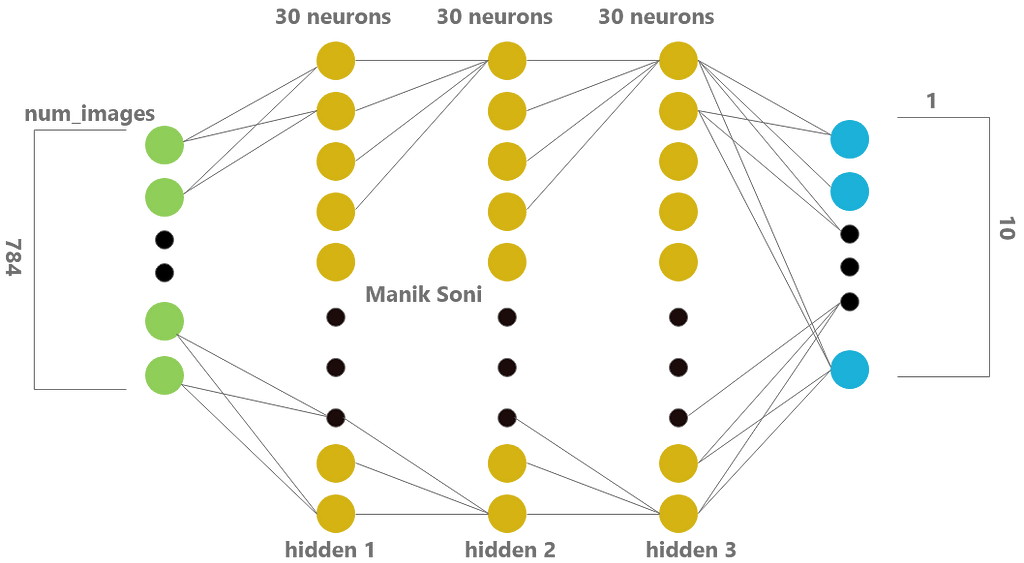 DNN architecture with 3 hidden layers
DNN architecture with 3 hidden layers
You can access to the complete code here. For this article I’m just using snapshots of the code. I have used Deep Learning Studio’s Jupyter lab to execute the code. If you’re unaware of this awesome Deep Learning Tool, check out my article on that.
Model with 1 hidden layer.
line 1: 784 denotes the input neurons,30 denotes neurons in hidden layer 1, 10 denotes number of outputs.
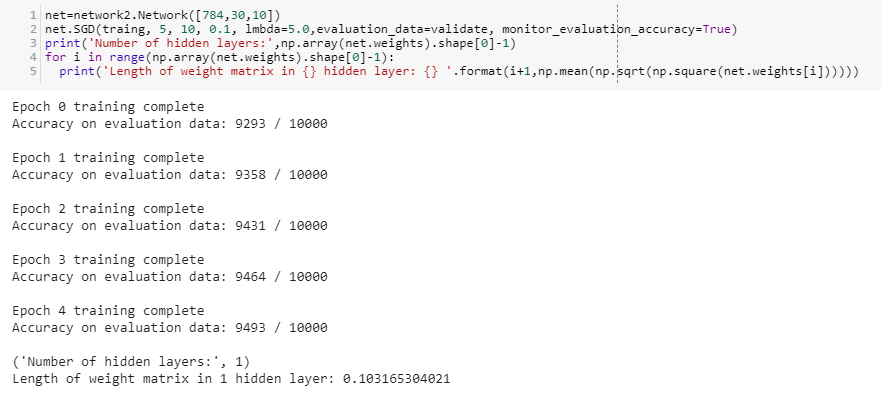 Accuracy of the model with 1 hidden layer.
Accuracy of the model with 1 hidden layer.
Here the term ‘Length of weight matrix of ‘ith’ hidden layer’ is the magnitude of the weight matrix of first hidden layer. It can be considered as the speed with which a particular hidden layer learns features(roughly).We’ll use this term to compare the speed of different hidden layers of different models.
Speed of First hidden layer in first model:0.103165(remember this!)
Model with 3 hidden layers: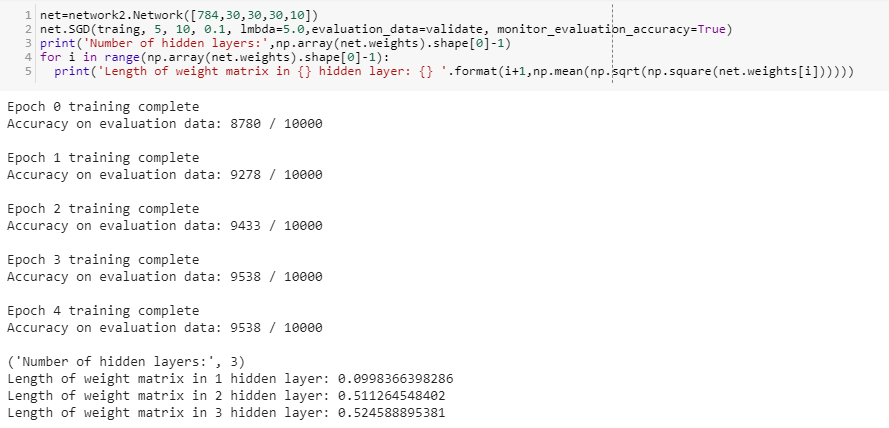 DNN with 3 hidden layers.
DNN with 3 hidden layers.
Observations:
- Learning speed of first hidden layer:0.09983(less than speed of previous model’s 1st hidden layer).
- Learning speed of ith layer is generally more than (i+1)th layer.
Let’s move on to MNIST with 4 and 5 layers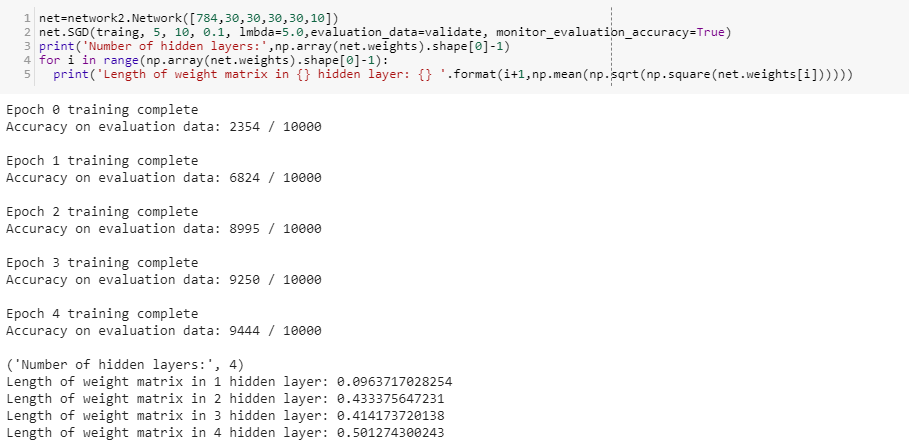
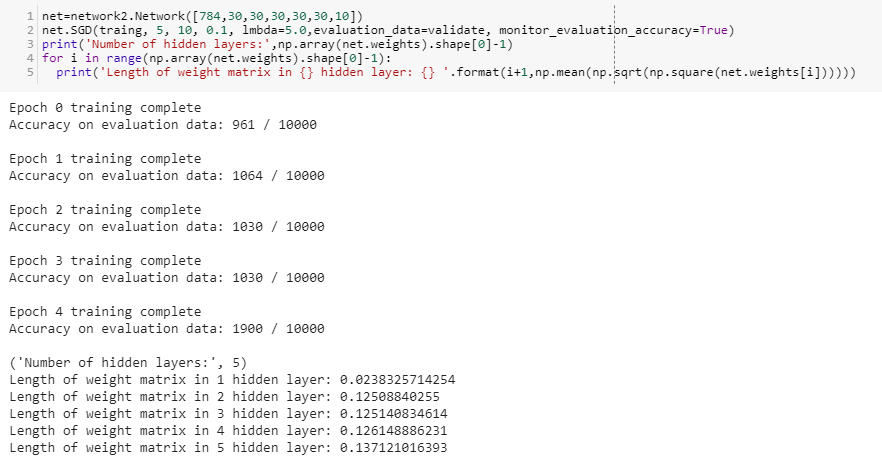 LEft :MNIST with 4 hidden layers, Right:MNIST with 5 hidden layers.
LEft :MNIST with 4 hidden layers, Right:MNIST with 5 hidden layers.
Learning speed of ith hidden layer keeps on decreasing as we have more deeper models i.e a model with more hidden layers.
In 5 hidden layers we even lose the accuracy of the model.
The Mathematical Reason.
Consider a neural network with 4 hidden layers with a single neuron in each matrix.
The computation graph for the neural network above is:
In forward propagation, we just multiply the input with weight matrices and add bias as shown above. We then find the sigmoid of the output.
During backprop, we find the derivative of the output w.r.t. different weight matrices in order to make our output more accurate. Suppose that we want to find derivative of C(output) w.r.t weight matrix (b1).
The terms which are going to be included in this are:
The sigmoid’(z1),sigmoid’(z2).. etc are less than 1/4. Because derivative of sigmoid function is less than 1/4. See below. The weight matrices w1,w2,w3,w4 are initialized using gaussian method to have a mean of 0 and standard deviation of 1. Hence ||w(i)|| is less than 1. Therefore, in derivative we multiply such terms which are less than 1 and 1/4. Hence on multiplying such small terms for a huge number of times we get very small gradient which makes the model to almost stop learning.
The reason that if we have deeper models than starting hidden layers will have low speed of learning is: we move deeper as we reach the starting hidden layers during backprop and hence more such terms are involved which makes the gradient small.
Similar is the case with exploding gradient, If we initialize our weight matrices with very large values, then the derivative will be very large and hence the model will have highly unstable training.
Thanks for Reading..guys.
If you find this article helpful do 👏 and share it.
Follow me on LinkedIn and medium and Subscribe to my YouTube channel:
- Manik Soni - Machine Learning Intern - HEAD Infotech India Pvt ltd - Ace2three.com | LinkedIn
- Manik Soni - Medium
Subscribe to my YouTube channel:
Exploding And Vanishing Gradient Problem: Math Behind The Truth was originally published in Hacker Noon on Medium, where people are continuing the conversation by highlighting and responding to this story.
Disclaimer
The views and opinions expressed in this article are solely those of the authors and do not reflect the views of Bitcoin Insider. Every investment and trading move involves risk - this is especially true for cryptocurrencies given their volatility. We strongly advise our readers to conduct their own research when making a decision.



